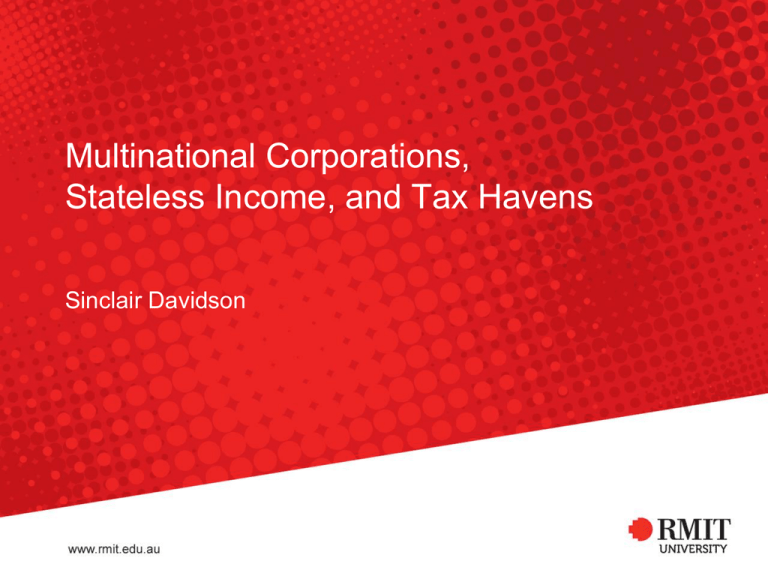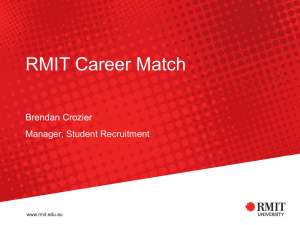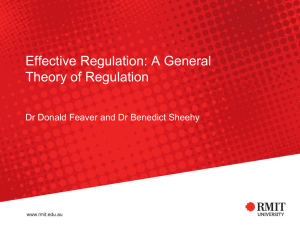Multinational Corporations, Stateless Income, and
advertisement

Multinational Corporations, Stateless Income, and Tax Havens Sinclair Davidson The public perception • There has been a lot of public protest about wellknown multi-national corporations not paying “their fair share” of tax. • Source: http://www.huffingtonpost.co.uk/2012/12/10/googlestarbucks-amazon-tax-spoof-logos_n_2270830.html RMIT University © 2013 Economics, Finance and Marketing 2 The public perception • Source: http://www.blog.rippedoffbritons.com/2012/10/starbucks-google-facebook-amazon-ibm.html RMIT University © 2013 Economics, Finance and Marketing 3 The Claim The decline in corporate-tax collection in recent decades has contributed to budget deficits. It has also aggravated income inequality: a company’s shareholders ultimately pay its taxes, and with a smaller tax bill, shareholders, who tend to be much more affluent than the average American, see their wealth increase. “It’s clearly a broken system,” said Michelle Hanlon, an accounting professor at M.I.T. Corporate taxes burst into the spotlight last week, with the release of a Senate committee report on Apple’s tactics to reduce its tax payments. More quietly, but perhaps more significantly, the House Ways and Means Committee has begun work on a potential overhaul of the tax code. Edward D. Kleinbard, a tax expert and former Democratic Congressional aide, said he had been impressed so far by the seriousness of the committee’s work. – David Leonhardt, Who Will Crack the Code?, The New York Times, May 25, 2013. RMIT University © 2013 Economics, Finance and Marketing 4 The Fiscal Challenge General government revenue 2018 2017 2016 2015 2014 2013 2012 2011 2010 2009 2008 2007 2006 2005 2004 2003 2002 2001 50 48 46 44 42 40 38 36 34 32 30 2000 % GDP Figure 1: The fiscal challenge faced by Advanced Economies General government total expenditure Source: International Monetary Fund, World Economic Outlook Database, April 2013 RMIT University © 2013 Economics, Finance and Marketing 5 The Fiscal Challenge Figure 2: The fiscal challenge faced by the Euro Area 52 50 % GDP 48 46 44 42 General government revenue 2018 2017 2016 2015 2014 2013 2012 2011 2010 2009 2008 2007 2006 2005 2004 2003 2002 2001 2000 40 General government total expenditure Source: International Monetary Fund, World Economic Outlook Database, April 2013 RMIT University © 2013 Economics, Finance and Marketing 6 The Corporate Income Tax and Fiscal Illusion 12 11 10 9 8 7 6 5 4 3 2 1 0 1965 1967 1969 1971 1973 1975 1977 1979 1981 1983 1985 1987 1989 1991 1993 1995 1997 1999 2001 2003 2005 2007 2009 % Figure 3: OECD Corporate income tax revenue as a percentage of GDP and total tax Corporate tax revenue as percentage of GDP Corporate tax revenue as percentage of total tax revenue Source: OECD.stat RMIT University © 2013 Economics, Finance and Marketing 7 The Corporate Income Tax and Fiscal Illusion Figure 4: Tax revenue by sector as percentage of total taxation 100% 90% 80% 70% 60% 50% 40% 30% 20% 10% 1965 1967 1969 1971 1973 1975 1977 1979 1981 1983 1985 1987 1989 1991 1993 1995 1997 1999 2001 2003 2005 2007 2009 0% Individuals Corporate Social Security Payroll Property Goods and Sevices Other Source: OECD.stat RMIT University © 2013 Economics, Finance and Marketing 8 Is the Corporate Tax Base being eroded? Figure 5: OECD Corporate Tax Revenue and Corporate Tax Rate 60 50 % 40 30 20 10 1981 1982 1983 1984 1985 1986 1987 1988 1989 1990 1991 1992 1993 1994 1995 1996 1997 1998 1999 2000 2001 2002 2003 2004 2005 2006 2007 2008 2009 2010 0 Average OECD Corporate Tax Rate OECD Corporate Income Tax Revenue to GDP Source: OECD.stat and Jane Gravelle (2012: Table A-1) RMIT University © 2013 Economics, Finance and Marketing 9 Is the Corporate Tax Base being eroded? • Peter Birch Sørensen has provided a test where the ratio of corporate income tax revenue to GDP is decomposed into its component parts: R/Y=R/C*C/P*P/Y – R = corporate tax revenue, – Y is GDP, – C is total corporate profit and – P is total profit earned in the economy. – R/C is a proxy for the average effective corporate income tax rate, – C/P is the share of corporate profits and – P/Y is the profit share of the economy. RMIT University © 2013 Economics, Finance and Marketing 10 Is the Corporate Tax Base being eroded? Figure 6: Corporate tax decomposition for the United Kingdom and the United States Source: OECD.stat and author calculations RMIT University © 2013 Economics, Finance and Marketing 11 Is the Corporate Tax Base being eroded? • Australia 70 60 50 % 40 30 20 10 0 2000 2001 2002 2003 R/Y RMIT University © 2013 2004 R/C 2005 C/P 2006 2007 2008 2009 2010 P/Y Economics, Finance and Marketing 12 Double Irish Dutch Sandwich • Source: AFR 20 June 2013 http://www.afr.com/p/markets/gaping_legislative_loopholes_mean_twxDlS6YlGZ6qqNos31HbM RMIT University © 2013 Economics, Finance and Marketing 13 A Critique of the Stateless Income Doctrine • Edward Kleinbard, Professor of Law at the University of Southern California, has developed the notion of “stateless income”. – Influential in the current debate. • Definition: – Income derived by a multinational group from business activities in a country other than the domicile (however defined) of the group’s ultimate parent company, but which is subject to tax only in a jurisdiction that is not the location of the customers or the factors of production through which the income was derived, and is not the domicile of the group’s parent company. – Complex and convoluted. – Stateless income thus can be understood as the movement of taxable income within a multinational group from high-tax to low-tax source countries without shifting the location of externally-supplied capital or activities involving third parties. RMIT University © 2013 Economics, Finance and Marketing 14 A Critique of the Stateless Income Doctrine • Kleinbard claims that stateless income is not equivalent to capital mobility or aggressive transfer pricing. – “The phenomenon of stateless income risks appearing vague, and its analysis tedious”. • The fact, however, that some multinational corporations do not pay (very much, if any) corporate income tax in any one particular jurisdiction is necessary but not sufficient evidence of wrong-doing on the part of those corporations. – “Stateless persons wander a hostile globe, looking for asylum; by contrast, stateless income takes a bearing for any of a number of zero or low-tax jurisdictions, where it finds a ready welcome.” • The basic problem with Kleinbard’s argument isn’t that MNCs don’t pay tax but that they don’t pay tax in the US. RMIT University © 2013 Economics, Finance and Marketing 15 A Critique of the Stateless Income Doctrine • The source of stateless income appears to be two-fold: – MNCs locate their valuable intellectual capital in those economies with legal regimes that value them most highly. – Highly mobile. – Easily expropriateable. – But … Kleinbard does not recognise this point. – Kleinbard views the source of stateless income as being, “an inevitable byproduct of fundamental international income tax norms” and “nations’ collective failure to agree on other critical international tax norms that would determine the “source” of income”. RMIT University © 2013 Economics, Finance and Marketing 16 A Critique of the Stateless Income Doctrine • Kleinbard’s position is fragile: – “the recognition of the separate tax personas of different juridical persons”. – “the general practice of treating interest on indebtedness as deductible to the payor”. – “the norms of freedom of contract”. – It is the ready acceptance by countries of the fantastic notions that – (i) a wholly-owned subsidiary has a mind of its own with which to negotiate “arm’s-length” contractual terms with its parent, – (ii) capital provided to the subsidiary by the parent somehow becomes the property of an independent actor (the subsidiary) with which it can take business risks that for tax purposes are not simply assimilated into those borne by the parent (as both provider of the capital and ultimate economic owner of the assets acquired therewith), and – (iii) a multinational enterprise that exists as a global platform to exploit a core set of intangible assets best is analogized to wholly independent actors taking on limited and straightforward roles in a vertical chain of production or a horizontal array of distribution of a product. RMIT University © 2013 Economics, Finance and Marketing 17 A Critique of the Stateless Income Doctrine • So what is he saying? – It is not at all clear that – separate tax personas, – deductibility of interest payments, – freedom of contract, – limited liability, and – the veil of incorporation, are “fantastic notions”. RMIT University © 2013 Economics, Finance and Marketing 18 A Critique of the Stateless Income Doctrine • Realising that his argument is weak, Kleinbard is reduced to scaremongering: – When unchecked, stateless income strips source countries (including the United States as the location of subsidiaries of foreign-controlled groups) of the tax revenues attributable to income generated in those jurisdictions. Its availability also distorts the investment decisions of multinational firms, and under current U.S. rules distorts a U.S. multinational firm’s decision whether to repatriate that stateless income back to the United States. • Problems: – Having just argued that the problem is a by-product of tax conventions stateless income is a definitional problem not base erosion. – He provides no evidence of distortion. – At worst this might be a governance problem not a tax problem. RMIT University © 2013 Economics, Finance and Marketing 19 A Critique of the Stateless Income Doctrine • Kleinbard claims: – Stateless income “destroys any possible coherence to the concept of the geographic source of income, on which all territorial tax systems rely”. – But that is wrong: – Stateless income tax planning does not make geographic source incoherent – it transfers it from one location to another. – As the WSJ indicated: – “We wonder what the Irish think of the spectacle of an American Senator expressing outrage that an American company doesn't pay enough Irish taxes.” RMIT University © 2013 Economics, Finance and Marketing 20 A Critique of the Stateless Income Doctrine • Kleinbard undervalues intellectual property. – “there is nothing in the [double Irish Dutch sandwich] structure that relies on any unique business model or asset of Google’s”. – As if Google’s business model itself is not intellectual property. – Why would firms choose to invest across a national border rather than simply export into that market, or licence production in another economy. – John Dunning argues that multinational firms own firm-specific intangible assets and can best exploit the value of those assets by investing across national borders. RMIT University © 2013 Economics, Finance and Marketing 21 Tax Havens and Multinational Corporations • What sort of multinational corporations establish activities in low-tax jurisdictions? – Large firms with high shares of international activity are the most likely to have haven affiliates, and firms in industries characterized by high R&D intensities and significant volumes of intrafirm trade similarly exhibit the greatest demand for tax haven operations. – Mihir Desai, Fritz Foley and James Hines Jr., (2006a) • Does investment in low-tax jurisdictions crowd-out investment in high-tax jurisdictions? – No. Desai, Foley and Hines also report that tax haven activity increases economic activity in nearby non-tax haven economies. • Finally if income shifting is occurring, how large are the quantities of potential tax revenue involved? RMIT University © 2013 Economics, Finance and Marketing 22 Tax Havens and Multinational Corporations • Finally if income shifting is occurring, how large are the quantities of potential tax revenue involved? – Dhammika Dharmapala and Nadine Riedel investigate the amount of profit shifting that actually occurs using 5400 European multinational affiliates over the period 1995 – 2005. – The magnitude of the profit being shifted, however, is only two per cent of parent corporation profits. – Consistent with estimates in the literature of the gains to be made from tax harmonisation. RMIT University © 2013 Economics, Finance and Marketing 23 Tax Harmonisation • Kleinbard has advocated tax harmonisation with a global corporate income tax rate of 25 per cent. Table One: Best Case Scenario of Tax Competition and Coordination. Competition Coordination Policy Variables Capital Tax Rates 12.7 42.3 Labour Tax Rates 44.4 44.4 Transfers 100.0 177.0 Infrastructure Spending 100.0 95.0 Other Variables Capital Stock 100.0 88.0 Employment 100.0 99.0 Profits 100.0 95.0 GDP 100.0 95.0 Average Real Wage Rate 100.0 96.0 Real Interest Rate 100.0 109.0 Welfare Gain %GDP 0.94 Source: Adapted from Peter Sørensen, 2004, Table 1, pg. 1201. RMIT University © 2013 Economics, Finance and Marketing 24 Conclusions • There is no such thing as “stateless income”, rather there is income that the governments of the United Kingdom and the United States do not tax because under their own legal systems that income is not sourced in their economy. • When these governments complain about stateless income, the question rather should be, “Why do the owners of intellectual property not locate their property in your economy?”. • An implicit assumption of the stateless income doctrine is that multinational corporations maximise their value to society only when they pay tax. • The argument is that the corporate income tax base is being eroded by aggressive tax planning on the part of multinational corporations – yet the evidence to support this argument is lacking. RMIT University © 2013 Economics, Finance and Marketing 25 Final word to the WSJ The Apple units are based in Ireland, so U.S. law does not consider them to be U.S. corporations subject to U.S. corporate tax. But since they are managed and controlled by Apple in the U.S., Irish law doesn't consider them Irish companies and thus they are also not subject to the 12.5% Irish corporate tax. This isn't alchemy; it's accountancy. … None of this required a Senate “investigation” to discover because Apple is constantly inspected by the IRS and other tax authorities. These tax collectors are well aware of Apple’s corporate structure, which has remained essentially the same since 1980. An Apple executive said Tuesday that the company's annual U.S. tax return adds up to a stack of paperwork more than two feet high. Review and Outlook, 2013, The Apple Tax Diversion: Senators beat up a U.S. success for following the tax laws they wrote, The Wall Street Journal, May 21, 2013. RMIT University © 2013 Economics, Finance and Marketing 26







